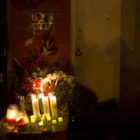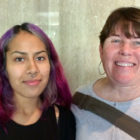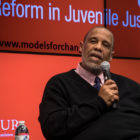
John Legend Plays Backup at Panel on Mass Incarceration
|
“We have allowed our most vulnerable children to be thrown away, to be traumatized, to be locked up in these jails and prisons and we have got to change this...
Juvenile Justice Information Exchange (https://jjie.org/tag/racial-bias/page/4/)

“We have allowed our most vulnerable children to be thrown away, to be traumatized, to be locked up in these jails and prisons and we have got to change this...

In cities across the country we've seen regressive youth justice and education policies that are supported — and even driven by — media narratives that...

Fifty years ago, Rev. Dr. Martin Luther King Jr.’s life was tragically taken in Memphis, Tennessee.

Schools can be places of healing or they can be places of harm. There is no in-between. I came to learn this through my work as an attorney working at the intersections of youth justice and education equity. I worked in Philadelphia fighting to keep marginalized youth in schools, and to ensure that for the youth who were pushed into juvenile prisons, those prisons were held accountable for providing education.

There are three pictures of Erica Garner; they are fixed to the chipped red brick wall with packing tape, just below a WigZone4Ever sign and just above the sagging and smudged plexiglass box covered in candles and filled with fake flowers and stuffed animals.

Humans of Restorative Justice stories highlight the individuals working to build and restore strong relationships in their communities. They are written and edited by David Levine, of The National Center for Restorative Justice, based on interviews with real-world practitioners.

Kim McGill was only 12 years old when she was first arrested and incarcerated for grand larceny. As a young girl, she had taken order requests from individuals, stolen and sold the items.

Within the scope of juvenile justice literature, studies highlight the need for both immediate and long-term reform measures. This is clearly pertinent given the existence of racial disparity in terms of treatment and confinement among youth in the United States. In fact, federal and state-level funding has been provided to address this dilemma during the past 10 to 15 years.

The bad news about girls just seems to keep coming, particularly if you pay attention to popular media. Girls are going “wild,” girls are “mean” (and certainly meaner than boys), and girls are even getting as violent as boys. Current media coverage of modern girlhood, at least in the United States, is virtually all grim. It is also clear as to the source of the problem — girls are getting more like boys — and that is bad news for girls.

James Bell, founder and president of the W. Haywood Burns Institute, told a gathering of juvenile justice reformers that it was time to begin “an uncomfortable” conversation about racial disparities in the youth justice system.